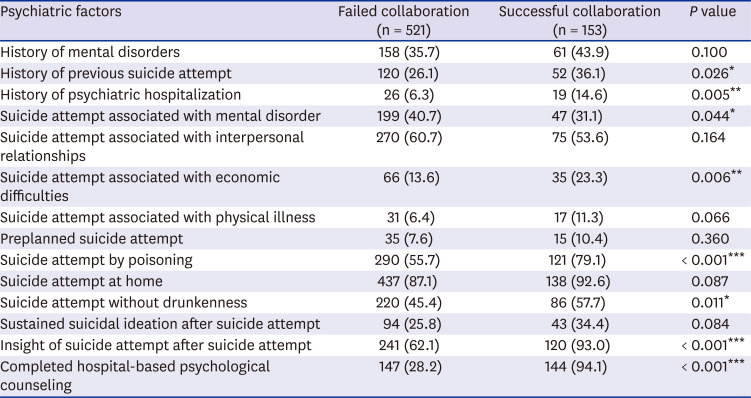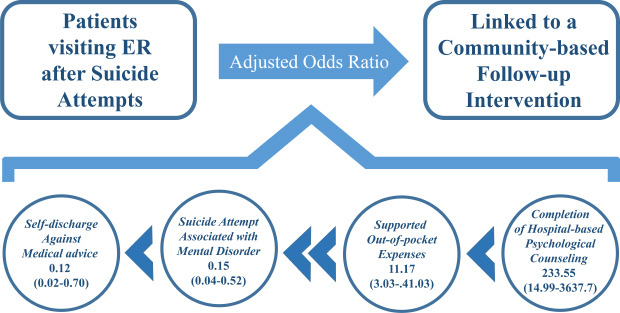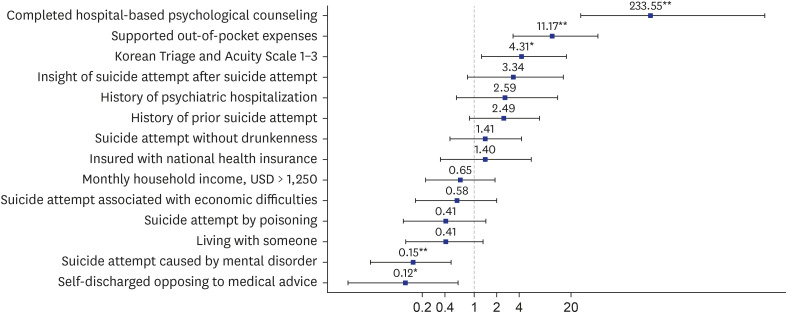1. Rudd MD, Goulding JM, Carlisle CJ. Stigma and suicide warning signs. Arch Suicide Res. 2013; 17(3):313–318. PMID:
23889579.

2. World Health Organization. Preventing Suicide: a Global Imperative. Geneva: World Health Organization;2014.
4. Ting SA, Sullivan AF, Boudreaux ED, Miller I, Camargo CA Jr. Trends in US emergency department visits for attempted suicide and self-inflicted injury, 1993-2008. Crisis. 2008; 29(2):73–80. PMID:
18664232.

5. Finkelstein Y, Macdonald EM, Hollands S, Sivilotti ML, Hutson JR, Mamdani MM, et al. Risk of suicide following deliberate self-poisoning. JAMA Psychiatry. 2015; 72(6):570–575. PMID:
25830811.

6. Artieda-Urrutia P, Parra Uribe I, Garcia-Pares G, Palao D, de Leon J, Blasco-Fontecilla H. Management of suicidal behaviour: is the world upside down? Aust N Z J Psychiatry. 2014; 48(5):399–401. PMID:
24589981.

7. Mann JJ, Apter A, Bertolote J, Beautrais A, Currier D, Haas A, et al. Suicide prevention strategies: a systematic review. JAMA. 2005; 294(16):2064–2074. PMID:
16249421.
8. Morthorst B, Krogh J, Erlangsen A, Alberdi F, Nordentoft M. Effect of assertive outreach after suicide attempt in the AID (assertive intervention for deliberate self harm) trial: randomised controlled trial. BMJ. 2012; 345:e4972. PMID:
22915730.

9. Wei S, Liu L, Bi B, Li H, Hou J, Tan S, et al. An intervention and follow-up study following a suicide attempt in the emergency departments of four general hospitals in Shenyang, China. Crisis. 2013; 34(2):107–115. PMID:
23261916.

10. Battaglia J, Wolff TK, Wagner-Johnson DS, Rush AJ, Carmody TJ, Basco MR. Structured diagnostic assessment and depot fluphenazine treatment of multiple suicide attempters in the emergency department. Int Clin Psychopharmacol. 1999; 14(6):361–372. PMID:
10565804.

11. Inagaki M, Kawashima Y, Kawanishi C, Yonemoto N, Sugimoto T, Furuno T, et al. Interventions to prevent repeat suicidal behavior in patients admitted to an emergency department for a suicide attempt: a meta-analysis. J Affect Disord. 2015; 175:66–78. PMID:
25594513.

12. Olfson M, Marcus SC, Bridge JA. Emergency treatment of deliberate self-harm. Arch Gen Psychiatry. 2012; 69(1):80–88. PMID:
21893643.

13. Cooper J, Steeg S, Bennewith O, Lowe M, Gunnell D, House A, et al. Are hospital services for self-harm getting better? An observational study examining management, service provision and temporal trends in England. BMJ Open. 2013; 3(11):e003444.

14. Shand FL, Batterham PJ, Chan JK, Pirkis J, Spittal MJ, Woodward A, et al. Experience of health care services after a suicide attempt: results from an online survey. Suicide Life Threat Behav. 2018; 48(6):779–787. PMID:
28960505.

15. Mork E, Mehlum L, Fadum EA, Rossow I. Collaboration between general hospitals and community health services in the care of suicide attempters in Norway: a longitudinal study. Ann Gen Psychiatry. 2010; 9:26. PMID:
20540725.

16. Kim JH, Kim JW, Kim SY, Hong DY, Park SO, Baek KJ, et al. Validation of the Korean Triage and Acuity Scale compare to triage by emergency severity index for emergency adult patient: preliminary study in a tertiary hospital emergency medical center. J Korean Soc Emerg Med. 2016; 27(5):436–441.
17. Korean National Statistical Office. 2018 Death and Cause of Death in Korea. Daejeon: Korea: Korean National Statistical Office;2019.
18. Jeon HJ, Lee JY, Lee YM, Hong JP, Won SH, Cho SJ, et al. Lifetime prevalence and correlates of suicidal ideation, plan, and single and multiple attempts in a Korean nationwide study. J Nerv Ment Dis. 2010; 198(9):643–646. PMID:
20823725.

19. Ministry of Health and Welfare (KR). Korea Suicide Prevention Center. White Book. Seoul: Suicide Prevention Center;2017.
20. Sleuwaegen E, Houben M, Claes L, Berens A, Sabbe B. The relationship between non-suicidal self-injury and alexithymia in borderline personality disorder: “Actions instead of words”. Compr Psychiatry. 2017; 77:80–88. PMID:
28646684.

21. Woo S, Lee SW, Lee K, Seo WS, Lee J, Kim HC, et al. Characteristics of high-intent suicide attempters admitted to emergency departments. J Korean Med Sci. 2018; 33(41):e259. PMID:
30288157.








 PDF
PDF Citation
Citation Print
Print





 XML Download
XML Download